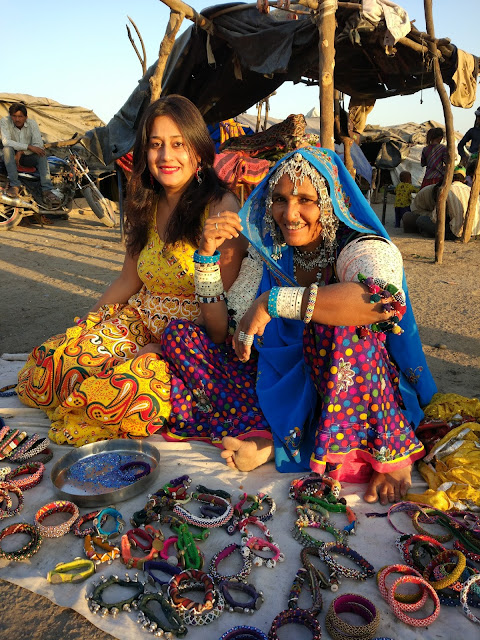World over,
Kutch is known for an exquisite variety of
traditional embroidery, weaving, colorful patchwork, block-printing
& bandhani (tie & dye) form of arts. Kutch has a wealth of
crafts not only in textiles but other art forms too.The untouched white
landscape offers a great background for adding color to the daily lives
with well known art forms like rogan art, lacquer work, terracotta
pottery, wood carving, leather & metal crafts. Mud & mirror work
adorn traditional houses known as bhoongas & garments worn by
natives tell a deeper story about the community they belong along with
social & marital status.
The achromatic landscape
of Kutch (also known as Kachch) is dotted with communities that weave
magic with their skilled hands. The challenging geographical conditions
have ingrained a manner of resourcefulness in the rural communities that
inhabit Kutch, one of the biggest districts in India. Many traditional
crafts evolved through necessity. Exquisite weaves & crafts found in
Kutch are symbols of the rich & diverse creative traditions of
Kutch.

Look closely & one finds significant
instances of interwoven cultures & communities that reflect in the
traditional arts & crafts of Kutch. The many tribal communities that
reside in Kutch have migrated from Pakistan, Afghanistan, Turkey,
Russia, Iran & other areas in Middle East & Central Asia. The
various communities found across different villages perform magic with
nimble fingers- whether its the art of weaving, patchwork, tie & dye
or more. Each community has its own lexicon of motifs & style of
embroidery. Lets look at some of the arts & crafts found in Kutch
that surely will win your heart.
 |
| Thread work, mirror work & bead work Kutchi embroidery |
Embroidery-Traditionally
women learnt the art of embroidery at an early age to prepare items for
their dowry. The art that probably dates back to centuries & passed
from generation to generation taught girls to hand embroider items of
clothing, door torans (hangings) & other items of daily use with
distinct stitches. Skilled stitches embellished with beads, mirror &
other ornate items are done on cotton or silk cloth. Some communities
embroider beautiful motifs inspired by Persian & Mughal arts. The
art of embroidery has gained popularity over the years & now holds
worldwide appeal. The art that started as a hobby for domestic use now
has become an quintessential medium of income. The popular forms of
embroidery belong to Rabari, Jat, Ahir & Soof communities.
 |
| An embroidered table cloth. |
Block printing-
Skilled indigo- tinted nimble fingers practiced the art of block
printing (especially the Ajrakh block printing style) in the village of
Dhamadka for many years till the devastating earthquake uprooted their
lives. Many communities like Rabari & Ahirs wear Ajrakh printed
clothes & gift such clothes on special occasions. Following the
earthquake, many artisans moved & settled in Ajrakhpur where they
practice the art presently. Wooden blocks are used to create intricate
patterns on clothes dyes in indigo (or other colors like mustard
yellow/green). The art form that originated many years ago when Muslim
Khatris settled in Dhamadka is now kept alive by few artisans.
Tie & Dye-
The art of tie & dye also known as Bandhani in Kutch is practised
by artisans with local available resources. Explained simply, this
technique calls for winding a thread around a section of cloth (cotton
or silk), dyeing it & removing the thread to reveal patterns &
motifs on the cloth. Practiced widely by the Khatri community, Bandhani
has featured on international runways & sustained the demands of the
changing markets.
 |
| A beautiful bandhani saree from Kutch. |
Leather art- It is said that
the leather from Kutch is so well treated that it can hold water &
has been used to make water jugs, shoes, water bottles & more. The
art of leather craft was introduced by the Dalit Meghwals of Rajasthan
who joined hands with Maldhari community. The craft is labor intensive
& at present struggles from challenges like lack of raw material,
labor shortage & rising raw material prices.
Weaving-
Though there are many weavers spread across Kutch, primarily the art
was practiced by Marwada & Maheshwari communities. Weavers craft
wooven textiles using cotton, wool obtained from sheep & camel.
There is a huge demand for textiles woven with camel wool for its
natural colors & durability. Another known form- Mashroo weaving was
traditionally practiced for Muslim communities. The community believed
that silk should not touch the body & hence weavers mixed cotton
& silk threads to create a unqiue textile that had cotton on one
side & silk on another.
We have touched upon a few
art forms in this blog, there are many other forms like wood carving,
silver work, rogan painting that are practiced by skilled artisans. Arts
& crafts are an important part of communities in Kutch that have
survived many changes and provides this land color & an unique
identity.







Comments
Post a Comment